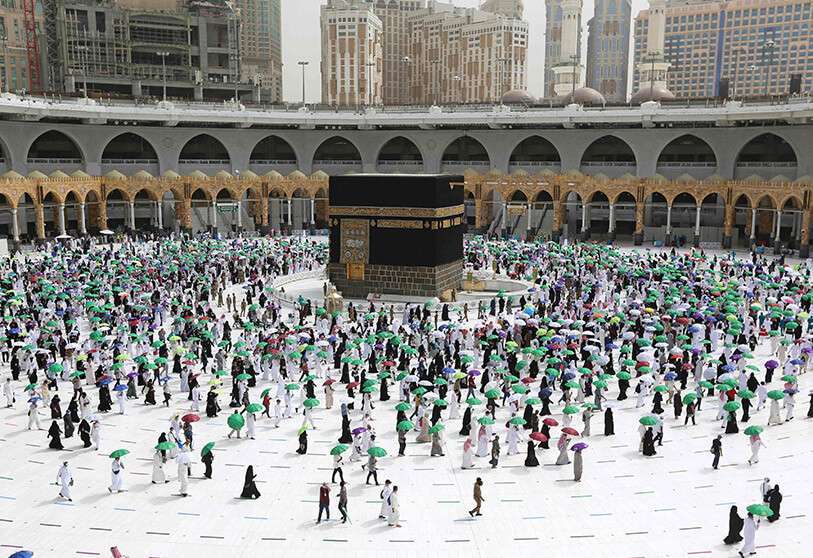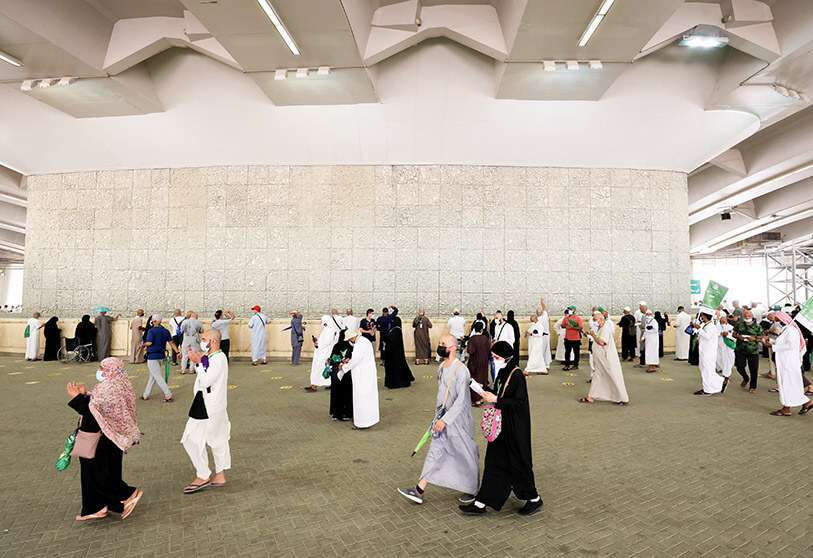The pilgrimage to Mecca in the age of the pandemic

Around 60,000 pilgrims paraded through the holy cities of Mecca and Medina retracing the same route that Muhammad took fourteen centuries ago and dressed in the "ihram", a habit for the occasion consisting of two open pieces of clean white cloth with no seams. The most important days began when the pilgrims, after spending the night in Mina, about eight kilometres east of Makkah, set out for Mount Arafat, a hillock about 15 kilometres east of the city, where they spend the afternoon chanting prayers.
During the evening, back in Mina, the crowds prepared to celebrate 'Eid al Adha' (The Feast of Sacrifice), the most important event in the Muslim calendar, in commemoration of how Abraham offered the life of his first-born son to God. Hundreds of lambs are sacrificed in Mina. The pilgrimage concludes with the ritual 'ramyi'. The pilgrims throw stones at three pillars symbolising Satan. The stones were previously sterilised and distributed by the Saudi authorities to prevent the spread of the coronavirus. Until 2020, the stone-throwing ritual used to be chaotic, with crowds thronging in front of the pillars of the devil's temptations in the Mina area, where stampedes and deadly incidents occurred.

To end the hajj, the pilgrims made seven more laps around the 'Kaaba', a cubic building housing a black stone that Muslims consider a piece of paradise and located in the courtyard of the Grand Mosque in Mecca, where they started the pilgrimage with seven more laps.
Tens of thousands of Muslims performed the last great ritual of the pilgrimage to Mecca or Hajj under strict security measures. This year's ritual was much more organised, with worshippers keeping a safe distance and respecting the security measures imposed by the Saudi kingdom. The authorities have organised the entry of pilgrims into the Grand Mosque through specific gates for each group and in accordance with the pandemic prevention rules, which have substantially changed this religious event. As a precaution, places of worship have been disinfected and the carpets have been marked to ensure that worshippers respect the two-metre social distance.

Saudi Health Minister Dr Tawfiq Al-Rabiah said that the health plan for this year's Hajj was a success, as no cases of COVID-19 infection were detected. "I would like to announce that this Hajj has been a success, with no coronavirus infection or any other epidemic disease," he said.
The danger was evident in an event that draws up to 2.5 million people, at least two-thirds of them from outside the country. In the end, the Saudi government decided to formally maintain the pilgrimage, but to limit the risk of mass infection by limiting foreign participants to worshippers already living in the kingdom. This year only 60,000 of Muhammad's acolytes living in the kingdom and vaccinated have been able to perform this once-in-a-lifetime ritual that is obligatory for all Muslims, if their physical and financial capacity allows them to do so.

Before the pandemic imposed social alienation worldwide, some 2.5 million pilgrims used to visit Islam's holiest sites in Mecca and Medina for the week-long Hajj and the lesser Umrah pilgrimage throughout the year, commemorations that together bring in around $12 billion a year for the kingdom, according to official figures.
After oil, pilgrimages are the country's second largest source of revenue and this year were expected to bring in $12 billion (10.66 billion euros). This loss is particularly significant at a time when not only has the price of oil fallen, but Riyadh has embarked on a process of economic diversification that included the expansion of religious tourism.










